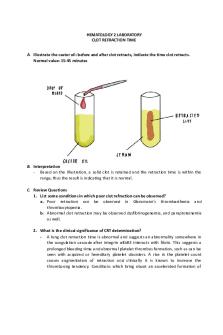3-28 blood clot test PDF

| Title | 3-28 blood clot test |
|---|---|
| Course | Human Anatomy & Physiology I |
| Institution | University of Alabama |
| Pages | 1 |
| File Size | 34.7 KB |
| File Type | |
| Total Downloads | 50 |
| Total Views | 154 |
Summary
blood clot test...
Description
1. Describe the three phases of the normal blood-clotting process as it happens in Hayden, when she cuts her finger making salad for dinner. a. This is hemostasis with 3 phases. The first phases is vasoconstriction so the middle layer of veins contract decreasing blood flow. Next platelets form. This is when the sticky platelet plug forms and adhere to the. Last is coagulation. This is when thrombin turns fibrinogen into fibrin. Fibrin is an insoluble clotting protein. It forms a mesh and clots the blood. 2. How does the body produce erythrocytes (red blood cells) in Alex? 1.Which situation do you predict to prompt the release of more erythropoietin into the blood: anemia or polycythemia? Explain. a. To trigger this the body needs to interrupt homeostasis. A situation could be Alex is running a race and he is huffing and puffing; he is out of breath. This is the stimulus. When this occurs the kidney releases erythropoietin. This hormone stimulates red bone marrow. The red bone marrow begins producing red blood cells therefore the O2 carrying ability of blood increases. 3. Explain the antigen-antibody response as it relates to blood groups. a. Blood groups have RBC antigens. Type AB has A and B antigens therefore it is the universal recipient. Type B blood only has B antigens so A is foreign. Since A is foreign type B blood cannot receive type A blood. If Type B receives type A blood the body will identify it as a foe and the body will respond drastically. If...
Similar Free PDFs

3-28 blood clot test
- 1 Pages

Blood vessels Test Bank
- 49 Pages

Synthetic Blood Paternity Test
- 3 Pages

legge 328-2000 riassunto
- 10 Pages

Psych 328 Project One
- 6 Pages

Legge quadro 328
- 4 Pages

ENV 328 notes
- 24 Pages

Blood
- 30 Pages

PSY 328 Project One Template
- 3 Pages

Hema 2 lab CLOT- Refraction-TIME
- 3 Pages

Blood basics
- 5 Pages

AUBF Blood
- 4 Pages
Popular Institutions
- Tinajero National High School - Annex
- Politeknik Caltex Riau
- Yokohama City University
- SGT University
- University of Al-Qadisiyah
- Divine Word College of Vigan
- Techniek College Rotterdam
- Universidade de Santiago
- Universiti Teknologi MARA Cawangan Johor Kampus Pasir Gudang
- Poltekkes Kemenkes Yogyakarta
- Baguio City National High School
- Colegio san marcos
- preparatoria uno
- Centro de Bachillerato Tecnológico Industrial y de Servicios No. 107
- Dalian Maritime University
- Quang Trung Secondary School
- Colegio Tecnológico en Informática
- Corporación Regional de Educación Superior
- Grupo CEDVA
- Dar Al Uloom University
- Centro de Estudios Preuniversitarios de la Universidad Nacional de Ingeniería
- 上智大学
- Aakash International School, Nuna Majara
- San Felipe Neri Catholic School
- Kang Chiao International School - New Taipei City
- Misamis Occidental National High School
- Institución Educativa Escuela Normal Juan Ladrilleros
- Kolehiyo ng Pantukan
- Batanes State College
- Instituto Continental
- Sekolah Menengah Kejuruan Kesehatan Kaltara (Tarakan)
- Colegio de La Inmaculada Concepcion - Cebu



